The Alcan Highway (signpost forest)
Carl Lindley was bug-bitten and sun-burned, sore, dirty, and exhausted. The Army 341st Engineers had brought him nearly 3,000 miles from home, and he was missing it so much he thought his heart would break. He was spending his 10-12-hour days building a 1,500-mile road through a sometimes-brutal wilderness; he spent his nights reading, playing cards, or having a drink with buddies. But the homesickness never abated. One day, on a plaintive whim, he carved out a placard that read “Danville, Illinios 2,759 miles”. It had an arrow pointing in the general direction of home, and Carl nailed it up on a post in Watson Lake, Yukon Territory.
Carl might not have been surprised that others followed his lead and put up their own sign-posts. Pointers to Ohio, New York, California, and many other soldiers’ homes were quickly to follow. But neither Carl nor anyone else could have foreseen that the quirk of behavior would be sustained over the next 73 years without faltering. As of 2015, there are more than 80,000 signs in the sign-post forest. They are of course from more walks of life than soldiering, and they come from all over the world.
A tiny portion of the multi-acre sign-post forest is shown here. You can click-zoom for more detail.
Most people know that “Alcan” is short for “Alaska Canada”. Here are some other tidbits about this famous roadway:
- The latest official name is actually the Alaska Highway. I still kinda like the nuances of “Alcan”, and everybody knows what I mean.
- The original road, and official designation, apply only to the stretch of highway going from Dawson Creek, B.C., to Fairbanks, AK – – about 1,500 miles. There are many other byways criss-crossing through western Canada and Alaska.
- The original road was created much farther inland than either of the other two possible routes (coastal and mountain). This was to keep it safer from Japanese invasion attacks.
- The first through road was built by 18,000 men and 150 women in about eight months. But it was crude and rough, and another year+ was required to re-route and re-build it. It’s been under continuous improvement since 1942. The entire route is now paved (except for various sections that undergo maintenance).
On our journey, we find today’s Alcan to be of near-US-Interstate quality in construction and ride, albeit with hugely less traffic. The road surface is generally smooth and trouble-free, but not always, so it’s good to keep alert.
A typical stretch of pavement – – – 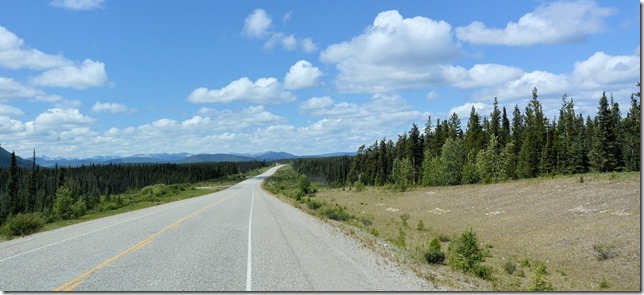
– – – can be interrupted at any time by several miles of coarse gravel. Speed limit doesn’t drop unless active work is underway, so we give oncoming trucks a wide berth and try not to collect any more windshield dings.
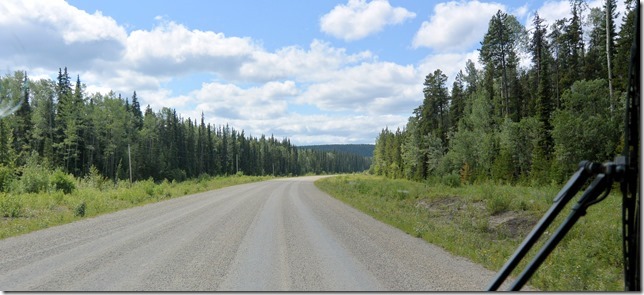
And then there are those stretches of road where you just don’t care what the road is made of. This area went on and on for twenty or thirty miles of post-card scenery.
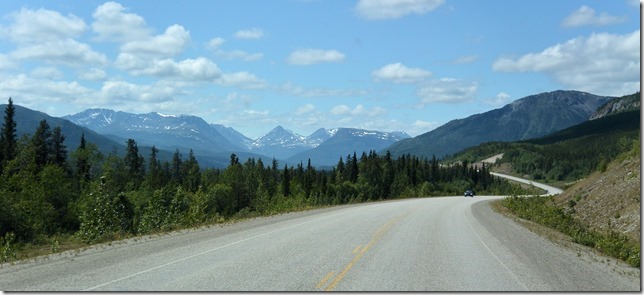
There are lots of bridges, some gigantic, some tiny. This one rates about medium. It has an all-steel roadway that makes a peculiar whining sound. I also make a similar sound, when I have to pass another motorhome on a bridge. We have roughly two feet of clearance between us. If that sounds like a lot, at 100mph closing speed it isn’t. It’s one of the few times that Karin can actually hear me sweat.
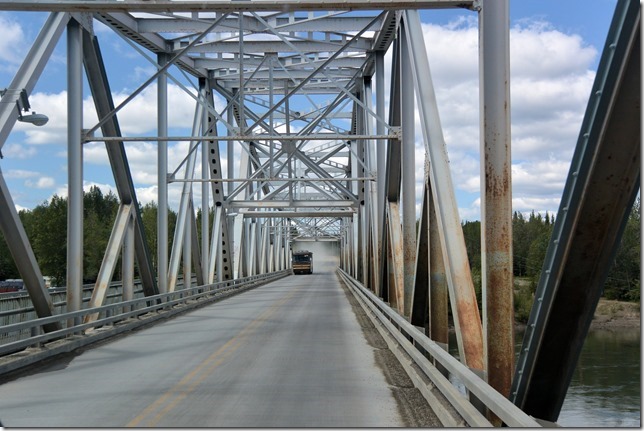
Watson Lake is a town of some history, but it’s a small place, only 1,600 residents not counting us tourists. We stopped here only for an over-night stay, and to see the sign-post forest – so didn’t take time to go the the namesake lake. But there was a tiny one, only 26 acres, just across from our RV park. It had a pleasant two-mile path weaving around the shoreline, so we decided to have a go.
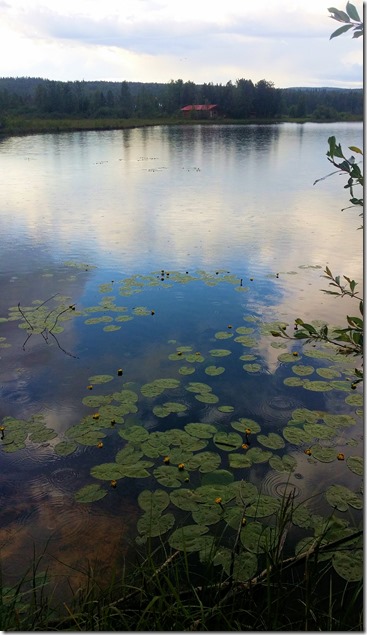
A standard afternoon thunder-shower speckled the lake just about half-way through our walk. We could hear the thunder in advance, and we knew we were in for a soaking. Lily pads have closed up with the darkened sky. The distant log cabin is just a bit farther away than our camp site.
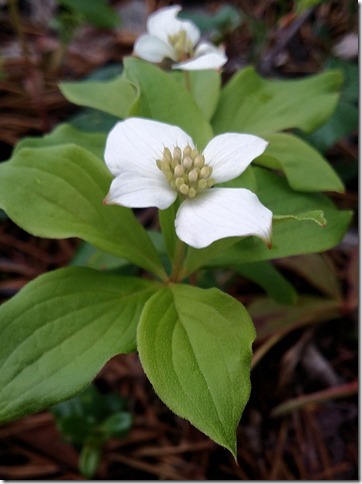
Things you learn on a walk. This little plant (leaves are about 1.5”/30mm long) has what look like four white petals. But they are actually the top leaves, which change from green to white. The real flowers are the tiny little 2mm buds in the middle.
(below) If I look sopping wet, it’s because I am. (Note to self: wear better rain-gear when you take a hike just before the evening monsoon.)
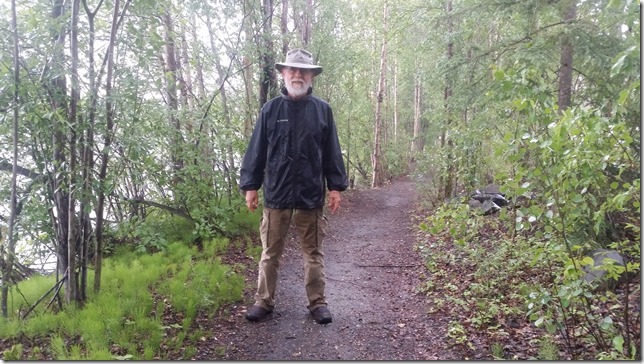
At the top of our newly-revised list of inauspicious churches is this little Catholic presence in Watson Lake. We thought Utah had some plain (Catholic) churches, but this one is the new leader.
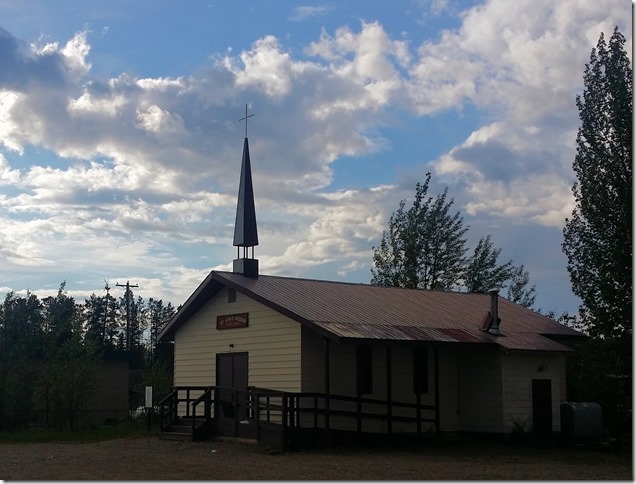
I’m sure there are other sights to see near this little town, but after church it was time to boogie on down the road, and we did. Mass is over, and we’re off to Whitehorse.
We spent a night in a non-descript camp on the edge of Teslin Lake. Isn’t that odd, how quickly we become accustomed to camping in splendid spots next to splendid waterways? Didn’t even get any pictures…. Then, the next day, we jogged off the Alcan to swing by Carcross and see “the world’s smallest desert” (which is really not a desert but an old lake bed’s sandy dune ecosystem).
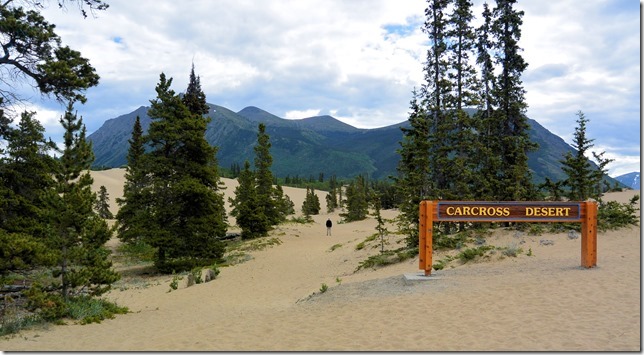
Virtually every single town we go through has its own story, and would fill a book. In fact, I’m reading a great little short book on the Alcan, “The Alaska Highway” by Murray Lindberg. (Got it at a visitors’ center.) It’s just 78 short pages and an excellent investment in understanding the origins of travel and commerce in the region. So, with every town’s history, comes the urge to dwell and investigate – – but even with our long, loose four-month schedule, there just isn’t enough time for all of them. We end up seeing some and skipping some.
Our diversion through Carcross (we may get back to Atlin, and certainly Skagway, on the same road, on our return trip), we roll easily into Whitehorse. The capital of the Yukon, and rightfully so at a huge (for the region) population of 27,000 or so.
Well, not actually into Whitehorse. We found a terrific Territorial Park (same thing as Provincial Park, State Park) about ten miles east of town at Wolf Creek. Once again (are you bored yet?) a fine camp site right alongside a pretty little creek, and a nearby two-mile trail going right by the Yukon River. How cool is that?
BTW – – for anyone planning travel in these parts, the annual non-resident pass to “government” camps (the Territorial Parks) is a stunning deal. For CA$50 (about US$40 as of this writing), you get unlimited access for a full year to any of the CA$12/night camps (first come, first-served). At Wolf Creek, on a Tuesday in June, we noticed that the sites were full by late afternoon. Stop early.
We’ve learned a LOT about driving, camping, and Internet-ing in Canada by now (hey, we have TWO WEEKS experience!!), and I’ll have a special post on this later on to share what we know. But for right now, we’ve got some exploring to do.
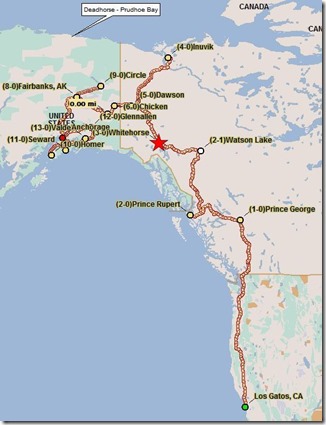
- Miles driven (Howie): 3,350
- Miles driven (Ralph): 809
- Days traveling: 32
- Miles from home: 2,401

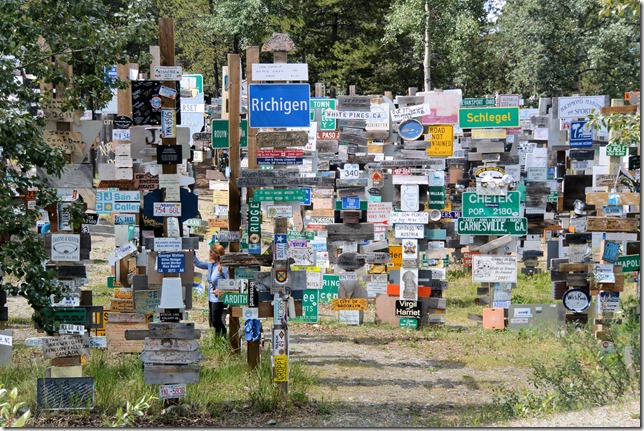
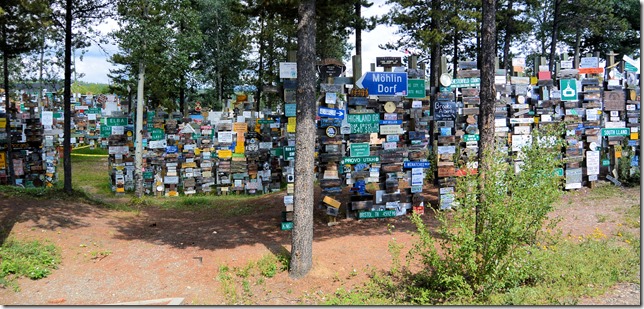
Thank you for providing a very fond memory with this page! (I stumbled on it while researching something else) As a long distance motorcyclist, I happened to attend Mass at this little church several years ago while taking a break after being on the road for several thousand miles while traveling from the Atlantic Coast to the Arctic Circle. Thanks!
Do you have a link for info/purchase of the Non-Resident CG pass for Yukon? I went to the Yukon Gov web site: http://www.env.gov.yk.ca/camping-parks/CampingPermits.php and it states that the annual pass is for Yukon residents only.
Thanks,
Al
This non-resident thing was a real problem for me a couple of times in Canada. Same issue came up in paying for my hotspot data, wouldn’t accept non-Canada credit card. As a non-resident, I naturally expected to pay more, but I didn’t expect to be totally refused. Funny, the Park system has online reservations and they do take U.S. cards. Go figure.
No, I’m sorry I don’t have a link. The way I accomplished this was to ask questions in Whitehorse, going from store to store until we found one that had non-resident annual campground permits. The stores all take U.S. credit cards of course. The store I finally ended up at was Canadian Tire, and they’re everywhere. (Don’t be fooled by the title, it’s a home/auto/sporting store chain.)
Beautiful pictures. Enjoyed the clear picture of the Bunchberry flower. Common in th mountains of the Cascades. Mountains are beautiful but take more of the wildflowers. There are so many and great in their natural setting. Took a cruise but going on alcan would be the best. Thanks
Greg,great write up again..please keep telling us the details you guys encountering…All your stories are documented and I hope to use them next year..
tony and marlene
Thanks for sharing!
It was the roads between Whitehorse and the Alaska border on the Alaska Highway that were more chip and tar than paved. I see you are taking a different route into Alaska through Chicken. Anxious to read your post about that place!
Greg, I don’t think you have talked about the bugs yet. 🙂
Reply about bugs and totem poles…
The mosquitoes are occasionally quite pesky, but really no worse than a hike in the Sierras. We’ve not yet been besieged by clouds of them (but we were once in Oregon on the Rogue River).
The totems are scattered around here and there — seemingly always in a rather cheesy environment where I chose not to photograph them. I’ll try to get some aesthetically pleasant shots somewhere. There is a lot of territory left.
We are enjoying your adventures North! We have had this same trip planned for three years, but every year my Mother gets sick, falls or has some other ailment. Ah well, Alaska will still be there next year.
Anyway, We are traveling vicariously through you two. We wish you continued safe travels and a lot more of the beautiful vistas. We look forward to seeing them through your eyes. Thank you for sharing your memories and photos.
Sincerely, Joanna & John Prince
Madison, MS